Lori, Kev and I work together for nearly three years to raise awareness about the design, management, and condition of the rural road where Karl died. We lobby for funding to repair it. Later, we lobby for better road planning generally in the Tweed Shire: a more sophisticated and up-to-date “Safe Systems” approach to road safety.
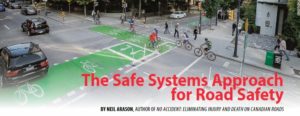
Initially, as Lori, Kev and I consider our activist options, our collective emotions are a bewildering mix of guilt, despair, confusion, anger, frustration, powerlessness, sadness, and a desire for justice: an outcome that would help others and save lives. Although we do not know it when we begin our organic activist process, we are well equipped to do this work (with a history of community activism and advocacy, emergency services experience, knowledge of road planning, design, management and safety, community engagement and empowerment, and municipal governance and planning). We have complementary skills: a balance of professional, on-the-ground experience, and academic knowledge.
We are naturally a good team.
The experience of working with my beloved friends is powerfully healing for me because it was easier for me to speak out in their company than in my lonely, mourning voice.
Small wins
Delivering my Victim Impact Statement to Tweed Shire Council helps build my competence and confidence. Soon our other “small wins” buoy us up.
I felt ever-so-slightly empowered.
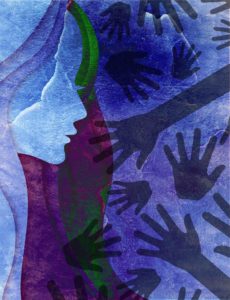
We are careful not to be tied to the notion of results. So, for example, we do not despair when the State Coroner refuses my request for a coronial inquest. He chooses (unwisely, I feel) to believe the Council’s account of the road changes and improvements they had undertaken following Karl’s death. We do not believe what they told him for a second, and later revelations of earlier nearby crashes on the Kyogle Road confirm our initial suspicions.
By this time, with our panel of senior expert academic and professional road safety advisors and crash data analysts, we know more about that road than anyone else, by a long shot. Later we learn that Mali, another grieving family member from the January 2015 crash (who lives in Uki), has launched a massive Facebook and internet petition campaign to get the Kyogle Road repaired. Nobody at Tweed Shire Council ever mentioned their names or their activism to us. They treat us as outlaws when, in fact, we are part of a movement. But we do not know it then.
But we do believe that our inquiries to the Coroner have at least heightened his awareness of critical system-wide road planning, safety and monitoring problems that are widespread in the Tweed Shire.
The humor the three of us experience in our encounters also heals us; often, we find ourselves laughing through our tears. Now we feel empowered and emboldened. I notice that the quality I miss the most — my courage — is slowly beginning to return.
our APPROACH
Gather data and analyze it. Repeatedly.
Basically, we try everything we possibly can. Several senior road safety academics are now advising us (in Australia and the UK), we have the assistance of expert road safety and crash data analysts in Sydney, we have access to several principled journalists, and we do a lot of the work ourselves. Lori and I keep writing articles for every journal we can think of. We explore every avenue to get the message out: that stretch of road is dangerous, and it must be fixed!
Kev Cracknell

Queensland miner Kev Cracknell is our “hands-on” road safety expert, with long experience in emergency services and occupational health and safety in Queensland mines and mining communities. He’s driven ambulances and fire trucks and attended many road crashes, some of them resulting in one or more deaths. Practical Kev keeps us focussed on the job at hand.
Kev’s site visit
A few days after our crash, at my request, Kev drives from Brisbane to the crash site to analyze the road conditions. He discovers many flaws in the road: a poor road camber, water pooling, erosion at the edge of the asphalt at the fog line, debris from other crashes, skid marks on the curb at the river edge of the road, and other debris on the road. (As the Council has no photos of the crash site, we later share ours with them.)
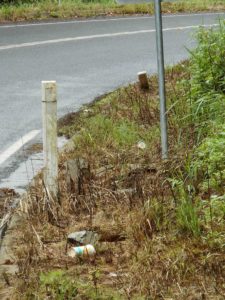
In December 2017, after driving along Kyogle Road, Rose Gardener alerts us to a spring bursting forth on the hillside at the crash site, causing significant erosion and spreading debris on the road. We speculate that the spring could have caused water pooling by the curb, as it is at the exact location where we hit the curb and veered over the roadway into the river.
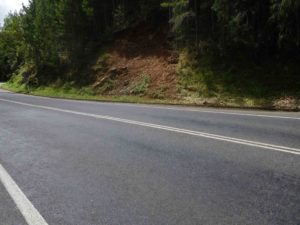
Immediately following our crash, in February 2016, using his car’s GPS, Kev works out the coordinates and takes many photographs, noticing a new “Danger: oil on road” signage and wondering why it was there, as there was no oil on the road.
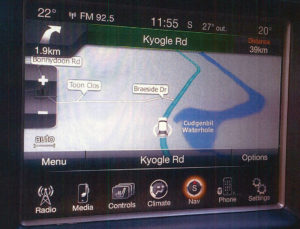
A few weeks later, when Kev and I visit the site a few weeks later to photograph it, I am surprised that I do not feel frightened.
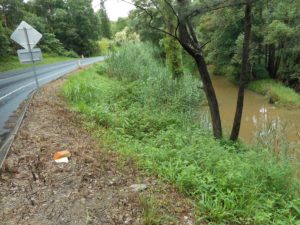
We can see the mark on the curb where our car hit it before tumbling into the river.
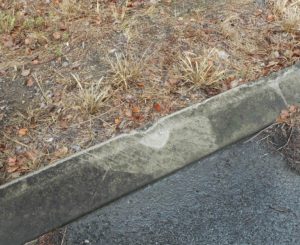
While I am not afraid to look at the crash site, the bank’s steepness and the massive drop into the river below shock me. I am grateful that both Karl and I had been knocked unconscious when our car tumbled that enormous distance (the police estimated 30 to 40 meters). I marvel that I had found the energy to climb back up the steep bank while clinging to a metal ladder.
“That’s adrenaline for you,” Kev yells, as we stand together on the edge of the road with cars and trucks whizzing by us.
